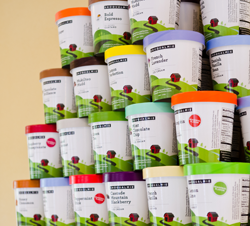Snoqualmie Ice Cream owner builds a sustainable business via executive education
Snoqualmie Ice Cream Owner Builds a Sustainable Business via Executive Education
Barry Bettinger and his wife always wanted to work together. Coming from upstate New York, Bettinger managed a large dairy plant for years. When he and his wife bought Snoqualmie Ice Cream 15 years ago, they were able to both live their dream of running a company together and create a Pacific Northwest sustainable competitor to Ben & Jerry’s and Haagen Dazs.
How? In part, through Foster School’s Executive Development Program.
Snoqualmie Ice Cream was growing, but Bettinger knew he needed to understand more fundamentals about running and growing a business. Wanting all the substance of an MBA but without the 2-year time commitment, he opted for the UW nine-month executive certificate program to gain new skills and grow his small business.
“I always reached out to the professors outside of class. I really got a lot out of it. I was totally absorbed for nine months,” says Bettinger.
Small business finance and strategy
“Finance professor Jennifer Koski met with me three times outside of class to discuss dividing a company into three segments—marketing strategy, financial management and operations. Each segment has its own strategy and she helped me separate that out in our own company and then tie it all back together.”
Management professor Charles Hill’s strategy classes also applied directly to running his business. “…the direction to go, how to price, even how to position ourselves in the marketplace. We use the Toyota system for pricing, so we compete right against Haagen Dazs and Ben & Jerry’s in the grocery store. That’s how I’ve designed it. Then we’ll make profits on the efficiency of operations.
“The other thing I got from Charles Hill was the realization that everything with a company comes from the mission and values. Our mission and values are based around two parts: whatever we make should be as perfect as possible and we have a responsibility to our customers, employees and community.”
Do they make perfect ice cream?
With flavors like Mukilteo Mudd (their top seller) blending four unique chocolates developed by world-renowned Belgian chocolatier Barry Callebautor or Raspberry Pomegranate sorbet, another best seller, you be the judge. Bettinger says some competitors pump over 50% air into their ice cream, but with each bite of Snoqualmie Ice Cream’s frozen dessert, you eat only 8% air. The thick, richness makes it a creamy, dreamy delight.
Sustainability and green practices are at the heart of Snoqualmie Ice Cream
 Bettinger and his wife built a small farm next to the ice cream factory that grows ingredients for their ice cream. 800 lavender plants and 100 blueberry bushes sit among fruit trees and a modern chicken coop. Beehives will be installed in 2013 to collect honey. Cream and milk are purchased from a single dairy farm in Washington state to ensure quality and reduce fossil fuel costs during transport. They bake nearly all of their ingredients that go into popular flavors such as gingerbread in their on-site kitchen. Solar panels are installed on their ice cream factory. A clean energy kiosk in the ice cream parlor in Maltby, WA educates customers about the benefits of green roofs, local farming and more.
Bettinger and his wife built a small farm next to the ice cream factory that grows ingredients for their ice cream. 800 lavender plants and 100 blueberry bushes sit among fruit trees and a modern chicken coop. Beehives will be installed in 2013 to collect honey. Cream and milk are purchased from a single dairy farm in Washington state to ensure quality and reduce fossil fuel costs during transport. They bake nearly all of their ingredients that go into popular flavors such as gingerbread in their on-site kitchen. Solar panels are installed on their ice cream factory. A clean energy kiosk in the ice cream parlor in Maltby, WA educates customers about the benefits of green roofs, local farming and more.
The “go local” movement has been growing nationwide and Snoqualmie Ice Cream offers a mostly organic, locally produced and sourced alternative to gourmet ice cream.
How did they become one of the top sustainable and local dessert makers in the Northwest? And why build a small farm next to their core business—the factory?
“The ingredients we were getting came in with oils and preservatives, so we hired a couple of pastry chefs to teach us how to make things in house. All the cookie dough, the caramel fudge. Pretty much everything that goes into the ice cream is made here. For us, it was a natural step on the path to start growing everything that we use,” says Bettinger.
“Sustainability is not just adding a piece of equipment. It’s more of a process, more of a journey.”
